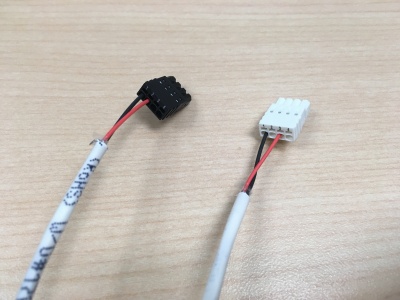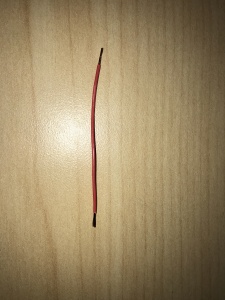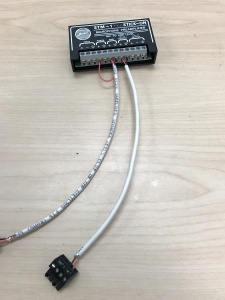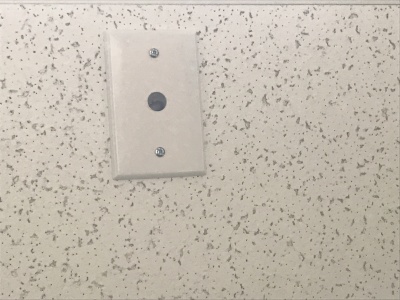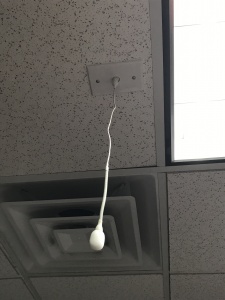Installing an Axis P3235 with a Shure MX202i Microphone
Contents
Required Parts And Tools
- Axis P3235
- RDL STM-1
- Female XLR Pigtail
- Shure MX202i Microphone
- S2 TT20 Torx security bit
- Wire Stripper
- Anchors and Screws (If wall mounted)
- Toggle bolts (If mounting to drop ceiling tile)
- 1/2" paddle bit
- 3.5mm Audio Cable
- 1 blank single gang wall plate
- Toggle Bolts for mic mount
- Drill bit and drill
- Phillips head drill bit or Phillips head screwdriver
- Small Flat head screwdriver
- Hole Saw
- B Connectors
- Stud Finder
- Cat5/6 Patch Cable (7ft-15ft recommended)
- Shielded 22/2 + ground Wire
- Fish Tape or Glow Rods
- Wind Screen (Inside MX202i kit)
- Rubber Stopper (Inside MX202i kit)
- 4 pin XLR-M to XLR-M Adapter (Inside MX202i kit)
Installation Instructions
- Locate the network drop above the ceiling either being a male Ethernet end (service loop) or a biscuit jack. This will have been ran back to the POE switch. If the switch does not have POE, a POE injector will need to be installed at the network closet.
- Remove the P3235 camera from its base using the T20 security bit. Using a stud finder, ensure there aren’t any studs any behind the camera base. Using a pencil, mark the 2 areas on the wall where the screws will be, and mark the opening where any cabling will pass through.
- Using the drill bit, drill the 2 screw markers, and place the anchors inside. Using the hole saw (recommended size 2” inches or less), drill a hole into the area where any cabling will pass through.
- Above drop ceiling, locate the network drop. If it is on a biscuit, a patch cable will be needed. Using the hole saw, drill a hole above the drop ceiling in line with the hole drilled where the camera will be mounted. If there isn’t any drywall above the ceiling, adjust accordingly to your circumstance.
- Using glow rods or fish tape, fish the network drop and 2 sections of 22/2 audio cable down the drywall. The sections of cable should be long enough to reach the destination where the STM-1 preamp microphone will be mounted in the drop ceiling. One cable will be for audio; the other will be to power the STM-1.
- Mount the Axis P3235 base to the wall using the screws associated with the anchors.
- Strip the jacket off the 22/2, revealing the red and black wires on both cables. Remove the string and strip the red and black jackets off the wire exposing the copper. Cut copper evenly. Remove the common (bare wire) completely.
- Connect the power cable to the IO phoenix connector (Red to 2, Black to 1).
- Connect the audio cable to the AUDIO phoenix connector (Red to 3, Black to 1- this is a shared ground).
- Plug in the network drop to the PoE NIC, the audio phoenix connector into the AUDIO port on the camera, and the IO phoenix connector to the IO port.
- Another shorter piece of 22/2 cable will also be needed (approx. 1 inch). Strip the jacket from the cable and remove all contents keeping only the red cable. On both ends of the red cable, strip off a piece of the jacket (See picture).
Connecting the STM-1
- Cut a short piece of 22/2 cable (approx. 1 inch). Strip the jacket and from the cable and remove all contents keeping only the red cable. On both ends of the red cable, strip off a piece of the jacket (See picture).
- Connect one end of the 1 inch audio cable to the +PWR terminal and connect the other end into the +PHNTM terminal.
- Connect the cable ran for power to both PWR terminals (Red to +, Black to the other terminal) of the STM-1. Connect the other side to the IO phoenix connector (Red to 2, Black to 1).
- Connect the cable ran for audio to both HI-Z OUTPUT terminals (Red to +, Black to the other terminal) of the STM-1. Connect the other side to the audio in portion of the audio phoenix connector (Red to +, Black to –).
- Using the Velcro that comes with the STM-1, attach the STM-1 to the wall above drop ceiling hidden from sight.
- The microphone will be connected via the input terminals of the STM-1 (Red to +, Black to -, ground to the ground terminal).
(NOTE; If there are 2 cameras in the room, duplicate these steps to get to the 2nd camera. HI-Z output can feed 2 cameras, but no more. If there are 2 Shure MX202i Microphones, duplicate steps. An STM-1 can power and gather audio from 2 Shure 202i mics.)
Connecting and Mounting the Microphone
- Asses the drop ceiling to decide best mounting placement for the MX202i. Avoid tiles adjacent to HVAC or fire safety devices.
- Drill a hole into the center of the single gang plate using the ½” paddle bit (if not prefabricated). Measure center of the drop ceiling tile and drill a similar hole with the ½” paddle bit. Align the single gang plate to the location of the microphone on your drop ceiling tile using a pair of toggle bolts.
- Run the MX202i through the ½” hole in the ceiling tile and single gang plate with the rubber stopper to secure the microphone in place and plugging the ½” hole .
- Adjust the length of the cable of the microphone to a desirable length, hiding the remainder in the ceiling near the STM-1. Attach the windscreen to the MX202i.
- Run the XLR mini cable to the STM-1 location. Connect the connect the XLR mini to the 4 pin Male XLR adapter.
- Strip away a portion of the red and black cables inside the pigtail, revealing the copper wire inside. The microphone will be connected via the input terminals of the STM-1 (Red to +, Black to -, ground to the ground terminal).
- Connect the female XLR to the Male XLR adapter
